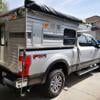If you have a PWM controller, then the voltage the solar panel is operating at is set by the battery (ie the panel voltage is pulled down to the 14V or what ever the battery is charging at). As long as the voltage drop in the wires is less than the solar panel voltage minus the charge voltage (~17 - 14 = ~3V) then the voltage drop in the wires has no effect on the power to the battery. So in this case you can sustain ~ 15% voltage drop in the wire before it impacts the power to the battery.
With an MPPT controller, you will see the voltage loss as a power loss as the controller converts this excess voltage to increased charge current. However the power loss is still only proportional to the voltage drop - so a 3% drop in voltage will lead to a 3% drop in charge current and a 3% drop in power to the battery (not a 15% drop). Also this is only under peak power production, under any other condition the loss is smaller.
So yes, there is a loss with MPPT, but my point was that the 3% guide line is an arbitrary figure and not a safety issue. I would argue that rewiring inside the headliner and behind the lift panel to get a 3% increase in efficiency is probably not worth the trouble. If you were worried about this, it would be better to rewire the panels in series and drop the current by a factor of 3.




















